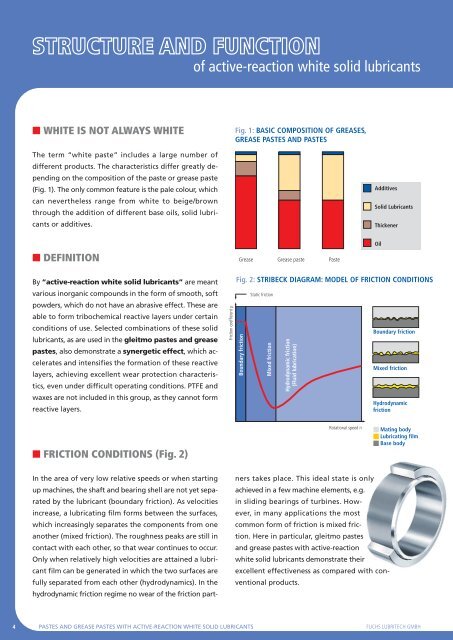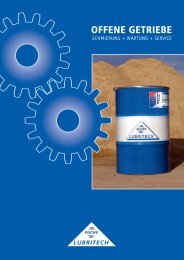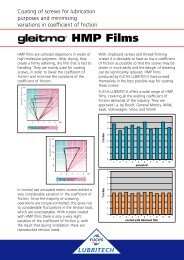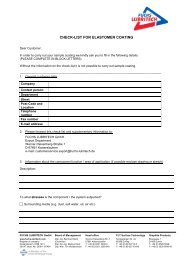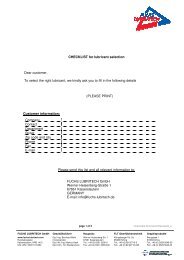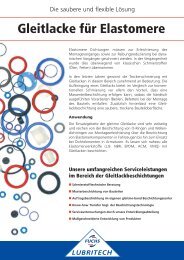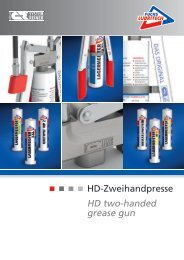english - FUCHS LUBRITECH GmbH
english - FUCHS LUBRITECH GmbH
english - FUCHS LUBRITECH GmbH
Create successful ePaper yourself
Turn your PDF publications into a flip-book with our unique Google optimized e-Paper software.
STRUCTURE AND FUNCTION<br />
■ WHITE IS NOT ALWAYS WHITE<br />
Fig. 1: BASIC COMPOSITION OF GREASES,<br />
GREASE PASTES AND PASTES<br />
TYPICAL FIELDS OF APPLICATION<br />
The term “white paste” includes a large number of<br />
different products. The characteristics differ greatly depending<br />
on the composition of the paste or grease paste<br />
(Fig. 1). The only common feature is the pale colour, which<br />
can nevertheless range from white to beige/brown<br />
through the addition of different base oils, solid lubricants<br />
or additives.<br />
TYPICAL TEST METHODS<br />
■ DEFINITION<br />
By “active-reaction white solid lubricants” are meant<br />
various inorganic compounds in the form of smooth, soft<br />
powders, which do not have an abrasive effect. These are<br />
able to form tribochemical reactive layers under certain<br />
conditions of use. Selected combinations of these solid<br />
lubricants, as are used in the gleitmo pastes and grease<br />
pastes, also demonstrate a synergetic effect, which ac-<br />
WEISSE PASTEN UND FETTPASTEN<br />
celerates and intensifies the formation of these reactive<br />
layers, achieving excellent wear protection characteristics,<br />
even under difficult operating conditions. PTFE and<br />
waxes are not included in this group, as they cannot form<br />
reactive layers.<br />
■ FRICTION CONDITIONS (Fig. 2)<br />
ADDITIVES<br />
In the area of very low relative speeds or when starting<br />
up machines, the shaft and bearing shell are not yet separated<br />
by the lubricant (boundary friction). As velocities<br />
increase, a lubricating film forms between the surfaces,<br />
which increasingly separates the components from one<br />
another (mixed friction). The roughness peaks are still in<br />
contact with each other, so that wear continues to occur.<br />
Only when relatively high velocities are attained a lubri-<br />
cant film can be generated in which the two surfaces are<br />
SELECTION fully separated from each other (hydrodynamics). GUIDE In the<br />
hydrodynamic friction regime no wear of the friction part-<br />
of active-reaction white solid lubricants<br />
Grease Grease paste Paste<br />
Additives<br />
Solid Lubricants<br />
Thickener<br />
Fig. 2: STRIBECK DIAGRAM: MODEL OF FRICTION CONDITIONS<br />
4 PASTES AND GREASE PASTES WITH ACTIVE-REACTION WHITE SOLID LUBRICANTS<br />
<strong>FUCHS</strong> <strong>LUBRITECH</strong> GMBH<br />
Friction coefficient µ<br />
Boundary friction<br />
Static friction<br />
Mixed friction<br />
Hydrodynamic friction<br />
(Fluid lubrication)<br />
Rotational speed n<br />
Oil<br />
Boundary friction<br />
Mixed friction<br />
Hydrodynamic<br />
friction<br />
ners takes place. This ideal state is only<br />
achieved in a few machine elements, e.g.<br />
in sliding bearings of turbines. However,<br />
in many applications the most<br />
common form of friction is mixed friction.<br />
Here in particular, gleitmo pastes<br />
and grease pastes with active-reaction<br />
white solid lubricants demonstrate their<br />
excellent effectiveness as compared with conventional<br />
products.<br />
Mating body<br />
Lubricating film<br />
Base body


